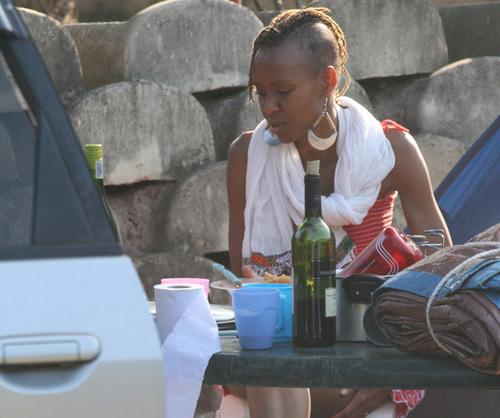“…I can see that you are here in the millions and my last warning to you is that you are to stand firm behind us so that we can prove to the world that when the African is given a chance he can show the world that he is somebody.” —Kwame Nkrumah, 1957.
There are a myriad of amazing stories surrounding the 2010 World Cup. While the tactical set-ups, the weather and lax refereeing stifled beautiful play, the World Cup was not without tremendous drama. Some of that drama surrounded the Ghanaian team that I argue carried the banner of the flag of Pan-Africanism.
As the tournament progressed it became apparent that only the “Black Stars” from Ghana were going to progress to the knock out rounds. In the round of sixteen, Ghana defeated the USA in a tight match. When that draw came through, many African Americans who had after being annoyed with white suburban look of the US team, had begun to embrace the team that is beginning to look more like America, were upset because it became clear their Pan-African sensibilities would have to clash with their excitement for the play of the US National team.
The feeling of Pan-Africanism and its validation by outside viewers became apparent to observers. Hotel staff was reported to be talking about the Ghana team. The South Africans who call their team “Bafana Bafana,” began to chant “Ghafana Ghafana.” European pundits marveled at the support for Ghana throughout Africa. Many wondered at the concept of Pan-Africanism. England does not celebrate when Spain or Germany win an international tournament, why should South Africans celebrate a win by Ghana?
However, there is a longer history. The shared struggle against colonialism, racism and the intellectual force and organizations related to Pan Africansim provide a basis for explaining why South Africans, Cameroonians, and African Americans all cheered for South Africa (see Singh Von Eschen, Merriwether etc). Former Ghanaian President Kwame Nkrumah and father of the Ghanaian nation built Pan Africanism into the DNA of the Ghanaian nation, borrowing the black star and colors from the Garvey movement.
This is the same spirit of Pan-Africanism and internationalism that caused celebrations throughout African and among African-descended peoples in the Americas at the election of President Barack Obama in the fall of 2008. In a world that wants to emphasize post-Racialism the bonds of Pan-Africanism forged in the early part of the 20th century are alive and well and carried around the world via electronic media like satellite television and the internet.
These feelings were further reinforced when Ghana went out to a bizarre incident that say Luis Suarez of Uruguay cynically batting the ball away from a sure goal for Ghana in the quarter-final resulting in a penalty as the last kick of open play. Asamoah Gyan of the Black Stars missed the penalty. Ghana went on lose the match to Uruguay in a penalty shoot out. A bizarre and cruel ending for the “Black Stars” and for the African Diaspora who collectively came within a handball and three penalty kicks of going to the semi-final.
As a result, of that drama Luis Suarez was booed in subsequent matches whenever he touched the ball by South African fans. Suarez became the villain of the Cup for spoiling African aspirations, not just for having caused Ghana to go out of the tournament.
One last issue for me demonstrated the centrality of Pan-Africanism in the consciousness surrounding the World Cup and football in general. As the Netherlands moved into the final, many of us wondered how the former colonial power would be treated by South Africans. Of course the descendants of the Dutch became the Afrikaners and the architects of the brutal apartheid regime that still marks the landscape of contemporary South Africa. However, these concerns were dismissed by the revelation by Ruud Gullit an afro-Surinamese immigrant to the Netherlands, that in the 1988 European Championships helped guide the Dutch team to a win. Gullit reported that Nelson Mandela while in prison at Robben island had followed the pursuits of Black Dutchmen like Gullit and Frank Rijkaard as part of the Dutch National team.
Their inclusion in the Dutch team offered Mandela hope, because the Dutch cousins of the Afrikaners had included these men in the Dutch team and embraced them.
It is that kind of hope and a concern or sense of linked fate with people of African descent across the world that is the linchpin of Pan-Africanism.
Mark Sawyer is currently an Associate Professor of African American Studies and Political Science at UCLA and the Director of the Center for the Study of Race, Ethnicity and Politics.
His published work includes a book entitled Racial Politics in Post Revolutionary Cuba that received the DuBois Award for the best book by the National Conference of Black Political Scientists and the Ralph Bunche Award from the American Political Science Association. He has written articles on the intersection between race and gender in modern Cuba, Puerto Rico and the Dominican Republic and additional work on the impact of race relations oip n democratic transition in Cuba. He also has interest in the area of race, immigration and citizensharound the globe. Mark is a fan of Chelsea FC.
Photo by Kwame Nyong’o.


